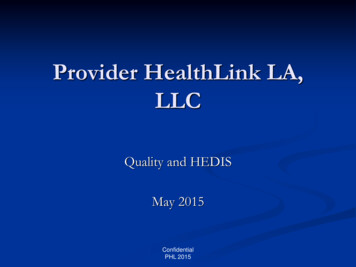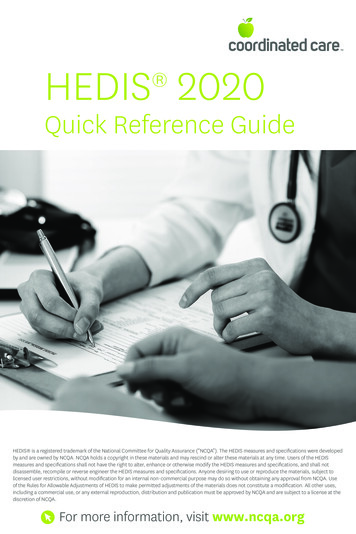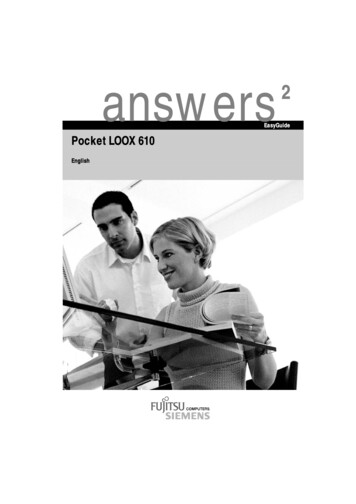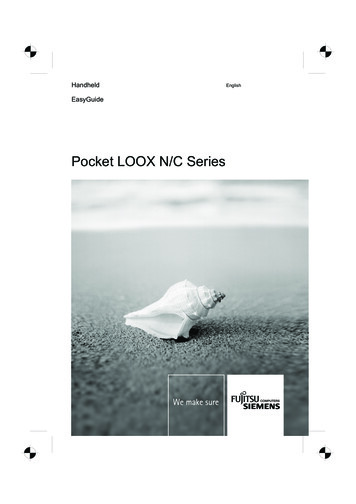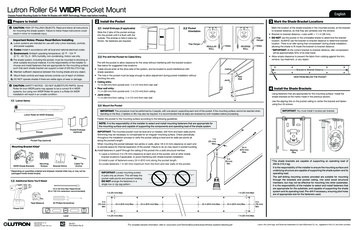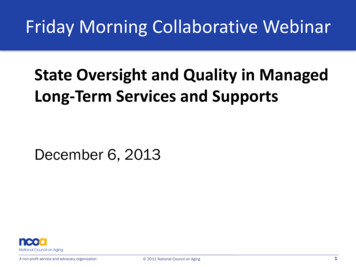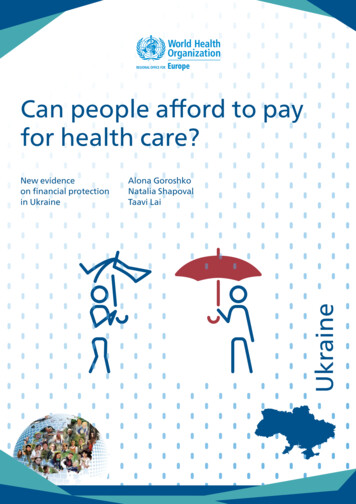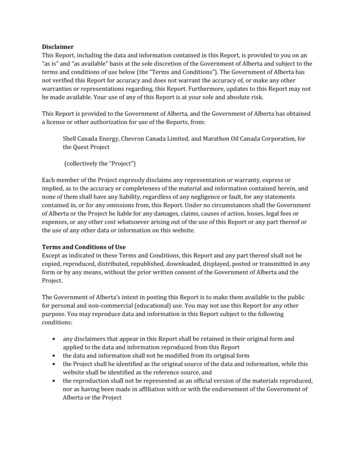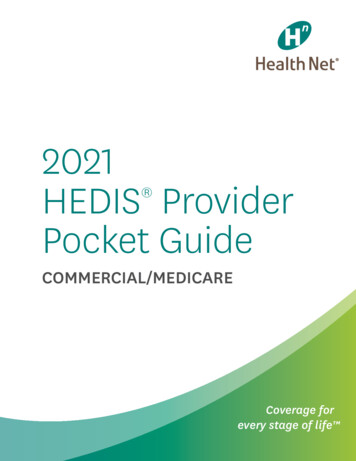
Transcription
2021HEDIS ProviderPocket Guide COMMERCIAL/MEDICARECoverage forevery stage of life
Table of ContentsGeneral TipsCalculating HEDIS Rates . . . . . . . . . . . . . . . . . . . . . . . . . 1HEDIS Improvement Tips . . . . . . . . . . . . . . . . . . . . . . . . . 1Behavioral HealthAntidepressant Medication Management (AMM) . . . . . . . 5Follow-up Care for Children Prescribed ADHDMedication (ADD) . . . . . . . . . . . . . . . . . . . . . . . . . . . . . . . . 9Initiation and Engagement of Alcohol andOther Drug Abuse or Dependence Treatment (IET) . . . . 14Child/Adolescent Preventive HealthChildhood Immunization Status –Combination 10 (CIS-10) . . . . . . . . . . . . . . . . . . . . . . . . . . 25Immunizations for Adolescents –Combination 2 (IMA-2) . . . . . . . . . . . . . . . . . . . . . . . . . . . 32Weight Assessment & Counseling for Nutrition &Physical Activity for Children & Adolescents (WCC) . . . . 35Adult/Older Adults Preventive HealthBreast Cancer Screening (BCS) . . . . . . . . . . . . . . . . . . . . 41Cervical Cancer Screening (CCS) . . . . . . . . . . . . . . . . . . . 44Colorectal Cancer Screening (COL) . . . . . . . . . . . . . . . . . 47Care for Older Adults (COA) . . . . . . . . . . . . . . . . . . . . . . . 52
Chronic ConditionsAsthma Medication Ratio (AMR) . . . . . . . . . . . . . . . . . . . 59Controlling Blood Pressure (CBP) . . . . . . . . . . . . . . . . . . . 64Comprehensive Diabetes Care (CDC) . . . . . . . . . . . . . . . 69Statin Therapy for Patients withCardiovascular Disease (SPC) . . . . . . . . . . . . . . . . . . . . . 84Care CoordinationTransitions of Care . . . . . . . . . . . . . . . . . . . . . . . . . . . . . . 95AddendumFrailty and Advanced Illness Exclusion Criteria . . . . . . . 105Value Sets for Event and Diagnosis Criteria . . . . . . . . . . 106Value Sets for Patient Setting Criteria . . . . . . . . . . . . . . . 111
IntroductionThe Healthcare Effectiveness Data and Information Set(HEDIS ) is a set of standardized measures developed bythe National Committee for Quality Assurance (NCQA) tomeasure, report and compare performance across healthplans .Providers have a direct impact on affiliated health plansand provider organization performance ratings based onpatient experience and the care provided .Use this HEDIS provider pocket guide to help increaseHEDIS scores by knowing what actions to take and how tocode correctly for the below services: Behavioral health Child/adolescent preventive health(continued)
Adult/older adult preventive health Chronic conditions Care coordinationThis guide serves as a helpful reference tool and is notintended to replace professional coding standards orbilling practices . Measures and codes in this guide arenot all-inclusive and can be changed, deleted or removedat any time . Measures are derived from the NCQA HEDISMeasurement Year 2020 and 2021 Volume 2 TechnicalSpecifications, released in July 2020 .
Refer to the table below to find out if the HEDIS measureapplies for commercial or Medicare product .Areas ealthMeasure DD1Follow-up Carefor ChildrenPrescribed ADHDMedicationIETInitiation andEngagementof Alcoholand OtherDrug Abuse atus –Combo 10COMM MCR
Areas ofFocusMeasure DescriptionChild/IMA-2AdolescentPreventiveHealth (cont .)WCC1Adult/Older sfor Adolescents –Combo 2WeightAssessment andCounseling forNutrition andPhysical Activityfor Children/AdolescentsBCS1Breast CancerScreeningCCSCervical CancerScreeningCOL1ColorectalCancer ScreeningCOA1Care for OlderAdultsAMR1AsthmaMedication RatioCBP1Controlling BloodPressureCDC1ComprehensiveDiabetes CareCOMM MCR
Areas ofFocusChronicConditions(cont .)CareCoordinationMeasure DescriptionSPC1Statin Therapyfor Patients withCardiovascularDiseaseSPD1Statin Therapyfor Patients withCardiovascularDiseaseTRC1Transitions ofCareCOMM MCR1HEDIS measures with new telehealth accommodations .
General TipsGeneral TipsHEDIS Improvement TipsCalculating HEDIS Rates
General Tips
General TipsHEDIS Improvement TipsUse the below tips to help improve your HEDISperformance scores: Submit claim/encounter data for servicesrendered. Ensure chart documentation reflects all servicesbilled. Bill (or report by encounter submission) for alldelivered services, regardless of contract status. Submit all claim/encounter data correctly and ina timely manner. Add CPT II codes to provide more details andreduce medical record request. Use the patient list provided by Health Net* toidentify and perform outreach to patients withgaps in care. Avoid missed opportunities by taking advantageof every office visit (including sick visits) toprovide preventive and chronic care. Review and evaluate appointment hours, access,scheduling process, billing and office/patientflow. Build care gap “alerts” within your electronichealth record (EHR) system.1
Calculating HEDIS RatesHEDIS rates can be calculated in two ways: administrativedata or hybrid data . Administrative data consists of claims or encounterdata submitted to the plan . Hybrid data consists of administrative data and sampleof medical record data . It also requires review of arandom sample of patient medical records to abstractdata for services that were rendered, but were notreported to the plan through claims or encounter data .Submitting accurate and timely claim and encounter datareduces the need for medical record review . If servicesare not billed or billed accurately, they are not includedin the calculation . Providers and other health care staffshould document to the highest specificity to aid with themost correct coding choice .QuestionsContact the Quality Improvement Department by emailat cqi medicare@healthnet .com . For more information,visit www .ncqa .org .2
BehavioralHealthBehavioral HealthAntidepressant Medication Management (AMM)Follow-up Care for Children Prescribed ADHDMedication (ADD)Initiation and Engagement of Alcohol and OtherDrug Abuse or Dependence Treatment (IET)
BehavioralHealth
Antidepressant Medication Management(AMM)Measure descriptionThe percentage of patients ages 18 and olderwith a diagnosis of major depression who weretreated with antidepressant medication, andwho remained on their medication treatment .Two rates are reported:Acute phase. The percentage of patients whoremained on the medication for at least 84days (12 weeks), for a total of 114 days from theearliest prescription dispense date .Continuation phase. The percentage ofpatients who remained on medication forat least 180 days (6 months), for a total of232 days from the earliest prescriptiondispense date .Antidepressant medicationsMiscellaneous antidepressants: Bupropion,Vilazodone and VortioxetineMonoamine oxidase inhibitors: Isocarboxazid,Phenelzine, Selegiline and TranylcyprominePhenylpiperazine antidepressants: Nefazodoneand Trazodone(continued)5
Psychotherapeutic combinations:Amitriptyline-chlordiazepoxide, Amitriptyline perphenazine, and Fluoxetine-olanzapineSNRI antidepressants: Desvenlafaxine,Duloxetine, Levomilnacipran, and VenlafaxineSSRI antidepressants: Citalopram,Escitalopram, Fluoxetine, Fluvoxamine,Paroxetine, and SertralineTetracyclic antidepressants: Maprotiline andMirtazapineTricyclic antidepressants: Amitriptyline,Amoxapine, Clomipramine, Desipramine,Doxepin ( 6 mg), Imipramine, Nortriptyline,Protriptyline, and TrimipramineProvider actionAssess patient’s symptoms of depression usingan age-appropriate standardized assessment,(e .g ., the Patient Health Questionnaire(PHQ-9)), at baseline and various points inthe patient’s progression .6
Encourage collaboration and communicationwith the patient’s behavioral health provideror encourage the patient to complementmedication with therapy . Assist the patientby calling their mental health benefitadministrator on the back of their ID card tohelp connect them to a mental health providerfor further treatment .If the patient already has a behavioral healthprovider, ask the patient for consent tocollaborate with their existing behavioralhealth provider, to further support medicationadherence .Provide reassurance that depression iscommon and can be treated .Educate patients on medication options,benefits and side effects, and come to a jointagreement on treatment plan .Discuss the importance of continuingmedication as prescribed and the risks ofstopping medication before six months .Schedule a follow-up appointment within fourweeks after starting a new prescription toreassess symptoms, side effects, and adjustthe type/dose of medication, if needed .Outreach to patients at risk of noncompliance(missing at least 1 refill) via phone calls,medication prompts, or case management .7
CodesMajor depression: ICD-10 F32 .0–F32 .4, F32 .9,F33 .0–F33 .3, F33 .41, F33 .9ExclusionsPatients are excluded if they: Did not have an encounter with a diagnosisof major depression during the 121-dayperiod: from 60 days prior to the IndexPrescription Start Date (IPSD) through theIPSD and 60 days after . Filled a prescription for antidepressantmedication 105 days before the IPSD . Are in hospice .Refer to the Addendum section at the end ofthe guide for hospice codes .Telehealth AccommodationsE-visits and virtual check-ins added to theevent/diagnosis .8
Follow-up Care for Children Prescribed ADHDMedication (ADD)Measure descriptionThe percentage of children newly prescribedan attention-deficit/hyperactivity disorder(ADHD) medication who had at least threefollow-up care visits within a 10-month period,one of which was within 30 days of when thefirst ADHD medication was dispensed .Two rates are reported:Initiation Phase. The percentage of patientsages 6–12 who had at least one follow-up visitwith a provider with prescribing authoritywithin 30 days of receiving a new ADHDmedication .Continuation and Maintenance Phase.The percentage of patients ages 6–12 whocontinued ADHD treatment for at least 210days and who, in addition to the visit in theInitiation Phase, had at least two follow-upvisits with a provider within 270 days(9 months) after the initiation phase ended .ADHD medicationsCNS stimulants: Dextroamphetamine,Dexmethylphenidate, Lisdexamfetamine,Methylphenidate, Methamphetamine(continued)9
Alpha-2 receptor agonists: Clonidine,GuanfacineMiscellaneous ADHD medications:AtomoxetineProvider actionUse an e-visit or virtual check-in for one of thevisits after the first 30 days . Only one onlineassessment is allowed during the continuationand maintenance phase .Schedule the first follow-up visit, while thepatient is still in the office, to occur within the30 days of the initial prescription to assess ifthe medication is working as expected andassess any adverse events .Consider prescribing the first ADHDmedication for a 21 or 30 day supply toencourage timely follow-up .Refill the medication after the patientcompletes their office visit .Schedule two more follow-up visits in the ninemonths after the first 30 days to continue tomonitor your patient’s progress . These visitsmust occur on different dates of service .10
Refer patient for psychosocial care, ifindicated . Assist the patient by calling theirmental health benefit administrator on theback of their ID card to help connect them to amental health provider for further treatment .Encourage communication and collaboration ifa mental health provider is currently involvedin their treatment .CodesFollow-up visits: CPT 96150–96154, 96156,96158, 96189, 96164, 96165, 96167,96168,96170, 96171, 98960–98962, 99078,99201–99205, 99211–99215, 99217–99220,99241–99245, 99341–99345, 99347–99350,99381–99387, 99391–99397, 99401–99404,99411, 99412, 99483, 99510;HCPCS G0155, G0176, G0177, G0409–G0411,G0463, H0002, H0004, H0031, H0034–H0037,H0039, H0040, H2000, H2001, H2010–H2020,S0201,S9480, S9484, S9485, T1015Telephone visits: CPT 98966–98968,99441–99443Telehealth modifier: 95, GTTelehealth visits will be identified by thetelehealth modifier or the presence of atelehealth point of service (POS) code11
Online assessments (e-visit or virtualcheck-in): CPT 98969–98972, 99421–99423,99444, 99458;HCPCS: G2010, G2012, G2061–G2063Note: Only one of the two continuation andmaintenance phase visits may be an e-visit orvirtual check-in .Follow-up visits with POS: CPT 90791,90792, 90832–90834, 90836–90840, 90845,90847, 90849, 90853, 90875, 90876, 99221–99223, 99231–99233, 99238, 99239, 99251–99255 With POS: 02 (telehealth), 03, 05, 07,09, 11–20, 22, 33, 49, 50, 52, 53, 71, 72ExclusionsPatients are excluded if they: Are in hospice . Refer to the Addendumsection at the end of the guide for hospicecodes . Filled an ADHD prescription 120 days prior tothe index prescription start date (IPSD) . Have a diagnosis of narcolepsy anytimeduring their history through December 31 ofthe measurement year (optional exclusion) . Had an acute inpatient encounter for amental, behavioral or neurodevelopmentaldisorder during the 30 days after the IPSD(initiation phase exclusion only) .12
Had an acute inpatient encounter for amental, behavioral or neurodevelopmentaldisorder during the 300 days after the IPSD(continuation and maintenance phase only) .Telehealth accommodationsTelehealth and telephone visits added to theinitiation phase numerator .E-visits and virtual check-ins added tothe continuation and maintenance phasenumerator and modified telehealthrestrictions .13
Initiation and Engagement of Alcohol andOther Drug Abuse or Dependence Treatment(IET)Measure descriptionThe percentage of adolescent and adultpatients with a new episode of alcohol orother drug (AOD) abuse or dependence whoreceived the following: Initiation of AOD Treatment . The percent ofpatients who initiate treatment through aninpatient AOD admission, outpatient visit,intensive outpatient encounter or partialhospitalization, telehealth or medicationtreatment within 14 days of the AODdiagnosis . Engagement of AOD Treatment . Thepercent of patients who initiated treatmentand who were engaged in ongoing AODtreatment within 34 days of the initiationvisit . Engagement of treatment is defined aspatients who either:1 . had an opioid treatment service thatbills monthly or had a visit that includedmedication administration within 34 daysof the initiation event;14
2 . for patients that initiated with amedication treatment event and hadtwo or more visits, where one was amedication treatment event;3 . for patients who did not initiate with amedication event had at least two visits,with at least one being a medicationtreatment event .Provider action Screen patients annually using astandardized tool, such as the Alcohol UseDisorders Identification Test (AUDIT)-C orNational Institute on Drug Abuse (NIDA), toidentify substance use issues . Document identified substance abuse in thepatient chart and provide the appropriatediagnosis code on all relevant claims,including associated follow-up visits andtreatment services . Schedule a follow-up visit within 14 days ofdiagnosis and at least two additional visitswithin 30 days of the first follow-up visit .Follow-up treatment that takes place on thedate of the diagnosis must be with differentproviders .15
Consider immediate referral to a behavioralhealth provider when giving a diagnosis ofalcohol or other drug dependence . Assistthe patient by calling their mental healthbenefit administrator on the back of theirID card to help connect them to a mentalhealth provider for further treatment . Ask the patient who already has a mentalhealth provider for written consent tocollaborate with their existing mental healthprovider, to support coordination of care andtreatment . Ensure the patient has writtenconsent to have information shared betweenproviders and the health plan . Educate patients on the effects of substanceabuse and all treatment options, includingmedication treatment (please see examplesfor medication treatment below) .Alcohol Use Disorder TreatmentMedicationsAldehyde dehydrogenase inhibitor:Disulfiram (oral)Antagonist: Naltrexone (oral and injectable)Other: Acamprosate (oral; delayed-releasetablet)16
Opioid Use Disorder TreatmentMedicationsAntagonist: Naltrexone (oral and injectable)Partial agonist: Buprenorphine (sublingualtablet, injection, implant)Buprenorphine/naloxone (sublingual tablet,buccal film, sublingual film)CodesAlcohol abuse and dependence:ICD-10 F10 .10, F10 .120, F10 .121, F10 .129, F .10 .14,F .10 .150, F .10 .151, F10 .159, F10 .180, F10 .181,F10 .182, F10 .188, F10 .19, F10 .20, F10 .220, F10 .221,F10 .229, F10 .230, F10 .231, F10 .232, F10 .239,F10 .24, F10 .250, F10 .251, F10 .259, F10 .26, F10 .27,F10 .280, F10 .281, F10 .282, F10 .288, F10 .29Opioid abuse and dependence:ICD-10 F11 .10, F11 .120, F11 .121, F11 .122, F11 .129,F11 .14, F11 .150, F11 .151, F11 .159, F11 .181, F11 .182,F11 .188, F11 .19, F11 .20, F11 .220–F11 .222, F11 .229,F11 .23, F11 .24, F11 .250, F11 .251, F11 .259, F11 .281,F11 .282, F11 .288, F11 .29Other drug abuse and dependence:ICD-10 F12 .10, F12 .120–F12 .122, F12 .129, F12 .150,F12 .151, F12 .159, F12 .180, F12 .188, F12 .19, F12 .20,F12 .220, F12 .221–F12 .222, F12 .229, F12 .23,F12 .250, F12 .251, F12 .259, F12 .280, F12 .288,(continued)17
F12 .29, F13 .10, F13 .120, F13 .121, F13 .129, F13 .14,F13 .150, F13 .151, F13 .159, F13 .180–F13 .182,F13 .188, F13 .19, F13 .20, F13 .220, F13 .221,F13 .229, F13 .230–F13 .232, F13 .239, F13 .24,F13 .250, F13 .251, F13 .259, F13 .26, F13 .27,F13 .280–F13 .282, F13 .288, F13 .29, F14 .10,F14 .120–F14 .122, F14 .129, F14 .14, F14 .150, F14 .151,F14 .159, F14 .180–F14 .182, F14 .188, F14 .19, 14 .20,F14 .220–F14 .222, F14 .229, F14 .23, F14 .24,F14 .250, F14 .251, F14 .259, F14 .280–F14 .282,F14 .288, F14 .29, F15 .10, F15 .120, F15 .121, F15 .122,F15 .129, F15 .14, F15 .150, F15 .151, F15 .159, F15 .180–F15 .182, F15 .188, F15 .19, F15 .20, F15 .220–F15 .222,F15 .229, F15 .23, F15 .24, F15 .250, F15 .251,F15 .259, F15 .280–F15 .282, F15 .288, F15 .29,F16 .10, F16 .120–F16 .122, F16 .129, F16 .14, F16 .150,F16 .151, F16 .159, F16 .180, F16 .183, F16 .188, F16 .19,F16 .20, F16 .220, F16 .221, F16 .229, F16 .24,F16 .250, F16 .251, F16 .259, F16 .280, F16 .283,F16 .288, F16 .29, F18 .10, F18 .120, F18 .121, F18 .129,F18 .14, F18 .150, F18 .151, F18 .159, F18 .17, F18 .180,F18 .188, F18 .19, F18 .20, F18 .220, F18 .221, F18 .229,F18 .24, F18 .250, F18 .251, F18 .259, F18 .27,F18 .280, F18 .288, F18 .29, F18 .90, F18 .920,F18 .921, F18 .929, F18 .94, F18 .950, F18 .951,F18 .959, F18 .97, F18 .980, F18 .988, F18 .99,F19 .10, F19 .120–F19 .122, F19 .129, F19 .14, F19 .150,F19 .151, F19 .159, F19 .16, F19 .17, F19 .180–F19 .182,F19 .188, F19 .19, F19 .20, F19 .220–F19 .222,F19 .229, F19 .230–F19 .232, F19 .239, F19 .24,18
F19 .250, F19 .251, F19 .259, F19 .26, F19 .27,F19 .280, F19 .281, F19 .282, F19 .288, F19 .29Use the below visit codes along withone of the diagnosis codes above tocapture initiation and engagement of AODtreatment.IET stand alone visits: CPT 98960–98962,99078, 99201–99205, 99211–99215, 99241–99245, 99341–99345, 99347–99350, 99384–99387, 99394–99397, 99401–99404, 99408,99409, 99411, 99412, 99483, 99510;HCPCS G0155, G0176, G0177, G0396, G0397,G0409–G0411, G0443, G0463, H0001, H0002,H0004, H0005, H0007, H0015, H0016, H0020,H0022, H0031, H0034–H0037, H0039, H0040,H0047, H2000, H2001, H2010–H2020, H2035,H2036, S0201, S9480, S9484, S9485, T1006,T1012, T1015Detoxification visits: HCPCS H0008–H0014;ICD HZ2ZZZZ;ED visits: CPT 99281–99285;Observation visits: CPT 99217–99220Telephone Visits: CPT 98966–98968,99441–9944319
Online Assessments (e-visit or virtualcheck-in): CPT 98969–98972, 99421–99423,99444, 99458HCPCS G2010, G2012, G2061–G2063OUD Weekly Non Drug Service(with opioid abuse and dependencediagnosis): HCPCS G2071, G2074–G2077,G2080OUD Monthly Office Based Treatment(with opioid abuse and dependencediagnosis): HCPCS G2086, G2087OUD Weekly Drug Treatment (with opioidabuse and dependence diagnosis):HCPCS G2067–G2070, G2072, G2073IET Visit Group 1 and POS Group 1:CPT 90791, 90792, 90832–90834, 90836–90840, 90845, 90847, 90849, 90853, 90875,90876With POS: 02, 03, 05, 07, 09, 11–20, 22, 33,49, 50, 52, 53, 57, 58, 71, 72 and diagnosiscode (see above) for alcohol abuse anddependence, opioid abuse and dependence,other drug abuse and dependenceIET Visit Group 2 and POS Group 2:CPT 99221–99223, 99231–99233, 99238, 99239,99251–9925520
With POS: 02, 52, 53 and diagnosis code(see above) for alcohol abuse anddependence, opioid abuse and dependence,other drug abuse and dependenceAOD Medication Treatment: HCPCS H0020,H0033, J0570–J0575, J2315, Q9991, Q9992,S0109ExclusionsPatients are excluded if they: Are in hospice . Refer to the Addendumsection at the end of the guide forhospice codes . Had a claim/encounter with diagnosis ofAOD abuse or dependence, AOD medicationtreatment or an alcohol or opioid dependencytreatment medication dispensing eventduring the 60 days (two months) before theIndex Episode Date (IESD) .21
Childhood Immunization Status – Combination 10(CIS-10)Immunizations for Adolescents – Combination 2(IMA-2)Weight Assessment & Counseling for Nutrition& Physical Activity for Children & ild/AdolescentPreventive Health
Child/AdolescentPreventiveHealth
Childhood Immunization Status –Combination 10 (CIS-10)Measure descriptionThe percentage of children who turned age 2during the measurement year who had therequired CIS-10 immunizations .Provider actionSchedule a series of wellness visits with patientand follow up as needed .Review the child’s immunization status (i .e .immunization record, registry) prior to eachvisit .Update immunization records with shots givenat birth or by other providers (if available) andadminister needed vaccines .Advise the child’s parent which vaccines will begiven at the visit . If needed, address vaccineconcerns and misconceptions .Ensure medical record documentationincludes: Patient name Date of birth25
Date of service immunization wasadministered (not ordered) and one of thefollowing:– name of vaccine– immunization certificate of vaccineadministration by an authorized healthcare provider or agency– documented history of illness, adversereactions or a seropositive test result Parent refusalVaccines requiring more than one dose shouldbe administered at different dates of service .Indicate in the immunization record whichdose was given .Submit all immunizations to the immunizationregistry at cairweb .org to ensure continuityof care .26
CodesDoses4433311Name ofCodesantigenDTaP1CPT 90698*, 90700, 90723*1PCVCPT 90670;HCPCS G0009IPV1CPT 90698*, 90713, 90723*HiB1CPT 90644, 90647, 90698*, 90748*Hep B2CPT 90723*, 90740, 90744, 90747,90748*;ICD-10 3E0234Z, B16 .0, B16 .1, B16 .2,B16 .9, B17 .0, B18 .0, B18 .1, B19 .10,B19 .11;HCPCS G00102,4Hep ACPT 90633MMR2,4CPT 90707, 90710* or combinationof vaccines with all three antigens: Measles: CPT 90705;ICD-10 B05 .0–B05 .4, B05 .81,B05 .89, B05 .9 Rubella: CPT 90706;ICD-10 B06 .00–B06 .02, B06 .09,B06 .81, B06 .82, B06 .89, B06 .9 Mumps: CPT 90704;ICD-10 B26 .0–B26 .3, B26 .81–B26 .85, B26 .89, B26 .9(continued)27
Doses1212 or 3Name ofCodesantigenMMR2,4CPT 90707, 90710* or combination(cont .)of vaccines with all three antigens(cont .): Measles/rubella: CPT 90708 Mumps: CPT 90704;ICD-10 B26 .0–B26 .3, B26 .81–B26 .85, B26 .89, B26 .9Flu3CPT 90655, 90657, 90660, 90661,90672, 90685–90689;HCPCS G0008VZV2,4CPT 90710*, 90716;ICD-10 B01 .0, B01 .11, B01 .12, B01 .2,B01 .81, B01 .89, B01 .9, B02 .0, B02 .1,B02 .21–B02 .24, B02 .29, B02 .30–B02 .34, B02 .39, B02 .7–B02 .9Rotavirus1 Any of the following: 2 dose vaccine: CPT 90681 3 dose vaccine: CPT 90680 or 1 of the 2 dose vaccines and1 of the 3 dose vaccines listedabove: CPT 90680, 906811Do not count a vaccination administered prior to 42 days after birth .2Count seropositive test results or history of illness .3Do not count a vaccination administered prior to 180 days after birth . One ofthe two flu vaccines can be a live, attenuated influenza vaccine (LAIV)administered to the child at the age of 2.4Vaccine must be administered on or between the child’s 1st and 2nd birthdays .*The CPT codes are combination vaccines with multiple antigens:90698, 90710, 90723, 90748 .28
Exclusion codesPatients who are in hospice or have thefollowing vaccine contraindications areexcluded .For any vaccine: Anaphylactic reaction due to vaccine:ICD-10 T80 .52XA, T8052XD, T80 .52XSFor DTaP: Encephalopathy due to vaccine (withvaccine causing adverse effect code):ICD-10 G04 .32 Vaccine causing adverse effect:ICD-10 T50 .A15A, T50 .A15D, T50 .A15SFor MMR, VZV and influenza: Disorder of the immune system:ICD-10 D80 .0–D81 .2, D81 .4, D81 .6, D81 .7,D81 .89, D81 .9–D82 .4, D82 .8–D83 .2, D83 .8–D84 .1, D84 .8, D84 .9, D89 .3, D89 .810–D89 .813, D89 .82, D89 .89, D89 .9 HIV: B20, B97 .35, Z2129
Malignant neoplasm of lymphatictissue: ICD-10 C81 .00–C81 .49, C81 .70–C81 .79, C81 .90–C82 .69, C82 .80–C83 .19,C83 .30–C83 .39, C83 .50–C83 .59, C83 .70–C84 .19, C84 .40–C84 .49, C84 .60–C84 .79,C84 .90–C84 .99, C84 .A0–C84 .A9, C84 .Z0–C84 .Z9, C85 .10–C85 .29, C85 .80–C85 .99,C86 .0–C86 .6, C88 .2–C88 .9, C90 .00–C90 .02,C90 .10–C90 .12, C90 .20–C90 .22, C90 .30–C90 .32, C91 .00–C91 .02, C91 .10–C91 .12,C91 .30–C91 .32, C91 .40–C91 .42, C91 .50–C91 .52, C91 .60–C91 .62, C91 .90–C91 .92, C91 .A0–C91 .A2, C91 .Z0–C91 .Z2, C92 .00–C92 .02,C92 .10–C92 .12, C92 .20–C92 .22, C92 .30–C92 .32, C92 .40–C92 .42, C92 .50–C92 .52,C92 .60–C92 .62, C92 .90–C92 .92, C92 .A0–C92 .A2, C92 .Z0–C92 .Z2, C93 .00–C93 .02,C93 .10–C93 .12, C93 .30–C93 .32, C93 .90–C93 .92, C93 .Z0–C93 .Z2, C94 .00–C94 .02,C94 .20–C94 .22, C94 .30–C94 .32, C94 .80–C94 .82, C95 .00–C95 .02, C95 .10–C95 .12,C95 .90–C95 .92, C96 .0, C96 .2, C96 .20–C96 .22, C96 .29, C96 .4, C96 .9, C96 .A, C96 .Z Anaphylactic reaction to neomycin:No applicable codes .30
For Rotavirus: Severe combined immunodeficiency:ICD-10 D81 .0–D81 .2, D81 .9 History of intussusception: ICD-10 K56 .1For IPV: Anaphylactic reaction streptomycin,polymyxin B or neomycin: No applicablecodes .For Hepatitis B: Anaphylactic reaction due to commonbaker’s yeast: No applicable codes .Refer to the Addendum section at the end ofthe guide for hospice codes .31
Immunizations for Adolescents –Combination 2 (IMA-2)Measure descriptionThe percentage of adolescents who turn age13 during the measurement year who had therequired IMA-2 vaccinations .Provider actionMissing HPV vaccines are the primary reasonfor noncompliance: Promote consistent provider/clinicrecommendation of HPV vaccines topatients . Consider offering drop-in hours orafter-hours appointments for patientconvenience . Create alerts within your electronichealth record (EHR) to indicate when theimmunizations are due . Give call reminders for series vaccines . Reduce over-immunization and ensuretimely data submission by providing allcompleted vaccinations to the immunizationregistries (CAIR2, RIDE, PHIMS, SDIR, etc .) . Implement standing orders .32
Be sure your immunization claimsand records are clear about whichmeningococcal was given .HPV rates are reported for both females andmales .Ensure medical record documentation includespatient name, date of birth, dates of service,names of vaccines and the dates given (notdates ordered) .CodesMeningococcal serogroups A,C,W,Yvaccine (with dates of service on or betweenthe child’s 11th and 13th birthdays): CPT 90734Tdap (with dates of service on or between thechild’s 10th and 13th birthdays): CPT 90715HPV (two doses with dates of services at least146 days apart on or between child’s 9th and13th birthdays; or three doses on or betweenchild’s 9th and 13th birthdays if intervalbetween doses is less than 146 days):CPT 90649–9065133
Exclusion codesPatients who are in hospice or have thefollowing vaccine contraindications areexcluded:For any vaccine: Anaphylactic reaction to vaccine:ICD-10 T80 .52XA, T8052XD, T80 .52XSFor Tdap: Encephalopathy due to vaccine(with vaccine causing adverse effect code):ICD-10 G04 .32 Vaccine causing adverse effect:ICD-10 T50 .A15A, T50 .A15D, T50 .A15SRefer to the Addendum section at the end ofthe guide for hospice codes .34
Weight Assessment & Counseling forNutrition & Physical Activity for Children &Adolescents (WCC)Measure descriptionThe percentage of patients ages 3–17 whohad an outpatient visit with a PCP or OB/GYNduring the measurement year with evidence ofthe following: BMI percentile documentation . Counseling for nutrition .5 Counseling for physical activity .5For BMI component, medical records shouldshow the following: BMI percentile as a distinct % value, or BMI percentile plotted on an age-growth chart .Percentile ranges will not meet criteria;however, a distinct value such as 99% or 1%value is acceptable .Patient-reported biometric values should becollected by a PCP or specialist providing theweight assessment, and must be recorded,and dated in the legal health record .5Services rendered during a telephone visit, e-visit or virtualcheck-in meet criteria for these indicators .35
Provider actionTake advantage of well-child visits and sickvisits to complete this measure .Measure and record patient’s current heightand weight along with BMI percentile for ageresults (plotted on growth chart or reportedp
intended to replace professional coding standards or billing practices. Measures and codes in this guide are not all-inclusive and can be changed, deleted or removed at any time. Measures are derived from the NCQA HEDIS Measurement Year 2020 and 2021 Volume 2 Technical Speciications, released in July 2020.
